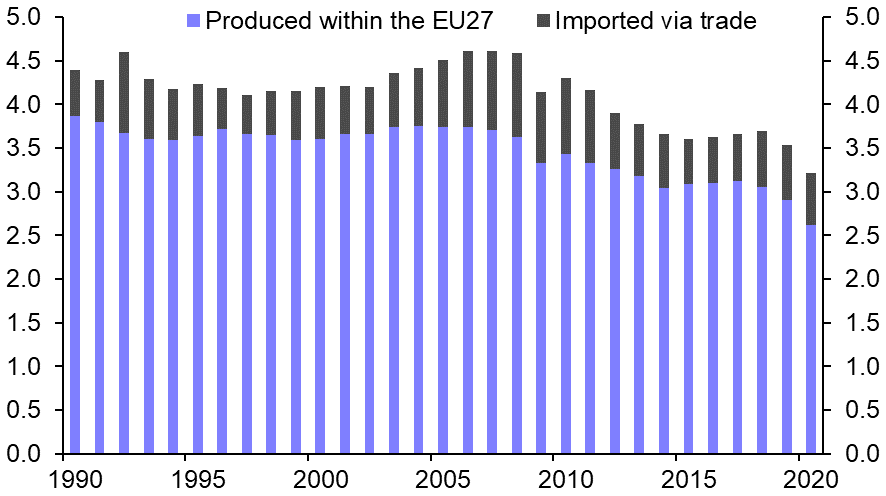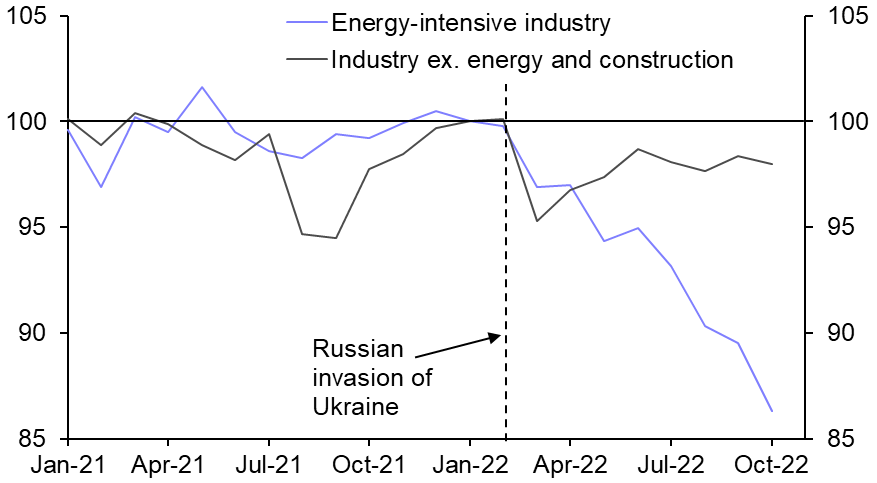- While today’s agreement on the EU’s “Carbon Border Adjustment Mechanism” leaves vital questions unanswered, it is a step towards the valid goal of making users pay for the emissions that they consume – wherever such emissions are produced. This Update answers six key questions on the topic.
- 1) What is “CBAM”? “CBAM” stands for Carbon Border Adjustment Mechanism and we discussed it in a Focus on the EU’s Emissions Trading Scheme (ETS) last year. In short, CBAM is an import tax that ensures importers of goods into the EU pay for the carbon emissions that were emitted in the production of those goods abroad; that is, it essentially brings foreign emissions under the umbrella of the EU’s domestic ETS. As shown in Chart 1, the EU “consumed” about 22% more CO2 than it “produced” in 2020.
- 2) Hasn’t the CBAM already been announced? The European Commission proposed it in July 2021 but the “provisional and conditional“ agreement announced today is the culmination of many months of technical work and negotiations between the European Commission, Council, and Parliament.
- 3) What sectors will be affected, and from when? The CBAM will focus initially on some of the most carbon-intensive industries, including iron and steel, cement, fertilisers, aluminium, and electricity and hydrogen. The plan is to implement a “simplified” version of the CBAM from October 2023, just aimed at collecting data, ahead of a gradual phase-in of the full mechanism by some as yet indeterminate date.
- 4) So this isn’t the final word on the matter? No, far from it. The agreement still needs to be adopted by EU member states and the European Parliament before it is final. More importantly, some important details have been left unresolved – particularly how to phase out the current allocation of free ETS credits to sectors that will be covered by the CBAM to avoid falling foul of global trade rules.
- 5) Isn’t the CBAM just protectionism by a fancy name? The rationale behind CBAM is not completely altruistic; it is aimed at levelling the playing field of carbon prices faced by EU-based and foreign producers and will dovetail with efforts to ensure security of supplies. (See here.) That said, even once the CBAM is in place, the backdrop of sky-high energy prices in Europe means that the region’s ailing energy intensive industries (see Chart 2) will still face a big handicap compared to producers where energy is cheaper.
- 6) Will the CBAM make a difference in lowering emissions? It won’t be a silver bullet from the off, and there will be valid questions over how foreign emissions should be measured and what should be counted. For example, focusing only on foreign emissions of carbon dioxide would ignore the methane emissions associated with coal power that underpins a lot of electricity production in China and India, say. (See here.)
- However, the CBAM is a welcome step towards pricing emissions systematically, and Dieter Helm has argued that a system that is “roughly right rather than precisely wrong” is a good place to start. More generally, to the extent that the imposition of the EU’s CBAM incentivises foreign producers of emissions to set equivalent or even higher carbon prices to avoid facing the tax, its benefits could spread far wider.
|
Chart 1: EU27 CO2 Emissions (Billion Tonnes per Year) |
Chart 2: Germany Manuf’ing Prod. (Jan. 2020 = 100) |
|
|
|
|
Sources: Global Carbon Project, Capital Economics |
Sources: Destatis, Capital Economics |
David Oxley, Head of Climate Economics, david.oxley@capitaleconomics.com

